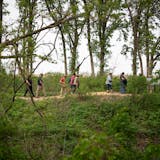Opinion editor's note: Star Tribune Opinion publishes a mix of national and local commentaries online and in print each day. To contribute, click here.
•••
As of right now, in the entire country, there is just a single federally funded study on preventing gun violence in America's schools. It started in September.
And in the days since 19 children and two teachers were gunned down in their classroom at Robb Elementary School in Uvalde, Texas, members of the research team of about a dozen scientists and educators have been furiously e-mailing back and forth, asking how they can speed up the work on their three-year grant.
"We really don't know what works and what doesn't to keep schools safe from events like Tuesday," said Charles Branas, a professor of epidemiology at Columbia University and one of the lead investigators in the study. School districts across the country are formulating policies in a vacuum without "any evidence to hang their hat on."
Wait, what? Columbine. Sandy Hook. Parkland. The federal government wasn't funding this kind of research before? The answer is no — not for more than 20 years.
In 1996, Congress passed the so-called "Dickey Amendment," named after the late Rep. Jay Dickey, who retired from Congress with an A-plus rating from the National Rifle Association. The measure effectively cut off funding for research on gun violence at the Centers for Disease Control.
Dickey had a change of heart following the 2012 massacre in a Colorado movie theater that killed 12 people. He partnered with a former nemesis, Mark Rosenberg, then director of the CDC's National Center for Injury Prevention and Control, to argue that gun violence should be treated like a public health crisis. In a 2012 op-ed article in the Washington Post, they implored Congress to restore the funding.
![Three weeks ago, Octavio Rodriguez switched from making transmission parts to casting parts for hospital bed brake assemblies at Twin City Die Castings. ] GLEN STUBBE • glen.stubbe@startribune.com Thursday, April 9, 2020 How employee-owned Twin City Die Casting, which just laid off 40 production workers of its 250 employees in what was supposed to be a good year, is trying to accelerate its pivot to growing medical parts business for ventilators, hospital beds, etc as it copes with instan](https://arc.stimg.co/startribunemedia/WNZYKGTZ5IYMUCO3KI5TR3N7WI.jpg?&w=80&ar=1:1&fit=crop)
djoles@startribune.com As boaters flock to Minnesota lakes and rivers this holiday weekend for the unofficial kick-off to the boating season, they'll face more inspections in and out of the water as local cities and counties ramp up their work to stop the spread of invasive species. Across the metro, more boat accesses will be staffed by watercraft inspectors thanks to $10 million funneled to county government programs this year, up from $4.5 million the state allocated last year. ORG XMIT: MIN1505222156290209 ORG XMIT: MIN1506021218440580](https://arc.stimg.co/startribunemedia/34QSKO44B2XKVNUZCO5SLJQSLY.jpg?&w=80&ar=1:1&fit=crop)

